Grenada: It was all so inviting…
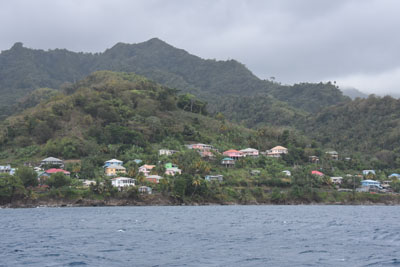
By Katherine Stone
The large island of Grenada is lush and green shrouded in mist
Anytime a Canadian is asked to travel south in the beginning of our spring, which this year was far from inviting, is a dream worth living. The thought of a sailing adventure, tropical breezes, the smell of spices and the warmth of the sun was too much – we HAD to go! The first thing we did was to dig out the copy of Ann Vanderhoof’s book, The Spice Necklace, we had acquired several years ago and to re-read the seven chapters of their adventures in Grenada. Not only should this be your required reading, but the book is loaded with scrumptious Caribbean recipes that are a must-try.
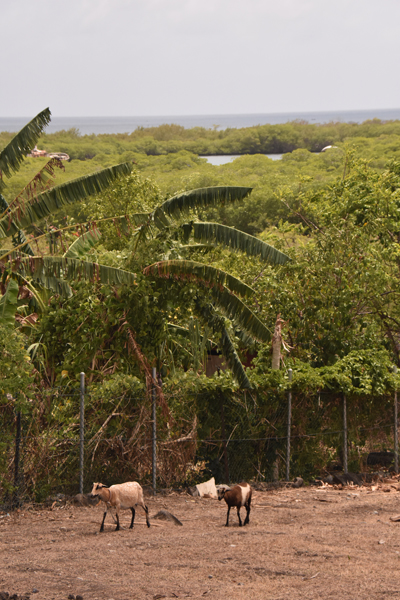 goats and sheep roam free during the dry season on Carriacou
goats and sheep roam free during the dry season on Carriacou
And so, our journey to Grenada began with our hosts, Horizon Yacht Charters, with their base in True Blue Bay, located only ten minutes from Maurice Bishop International airport and across the bay from St. George’s University. Four airlines fly to Grenada, many with non-stop flights. The well-trained and friendly team assembled by Jacqui and James Pascall, base directors, made us instantly feel at home. Although we opted to do a bare boat charter, there are also skippers, chefs, and housekeepers available. Their diverse fleet of sailboats range from 40-47 foot catamarans to 37-foot monohulls.
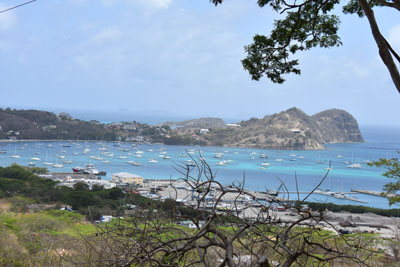
Tyrrel Bay moorings on Carriacou
This nation is composed of three unique islands: Grenada, Carriacou, and Petite Martinique, located at the southernmost tip of the Windward Islands, just 100 miles north of Venezuela and outside the hurricane belt. Billed as “the spice of the Caribbean” and stamped as the Caribbean’s prettiest place, you will never find a more authentic destination with untouched beauty, warm people, and a simpler way of life, undiscovered by crowds. The country produces the most spices per square mile, predominantly nutmeg, mace, and cinnamon, complimented by the production of fine organic cocoa and world-famous chocolate. The origin of the name Grenada most likely came from Spanish sailors who called the island Granada. After the French colonization in 1650 it was called “La Grenada”, and when it was ceded to the British under the Treaty of Paris, it was renamed Grenada.
Sailing conditions are blessed with a wonderful climate and rarely affected by storms. The winds run east to northeast at 15-20 knots with five to seven-foot seas from December through April and slightly less wind and waves the rest of the year, switching to the southeast. Temperatures vary little during the year, ranging from 28°C to 31°C. Dry season runs from January until May, but even in the ‘rainy season’ there are only brief showers during the day and any heavier rainfall tending to come in the evenings – the locals call rain “liquid sunshine” for good reason! There are over 50 unique beaches to explore and enjoy the sand between your toes.
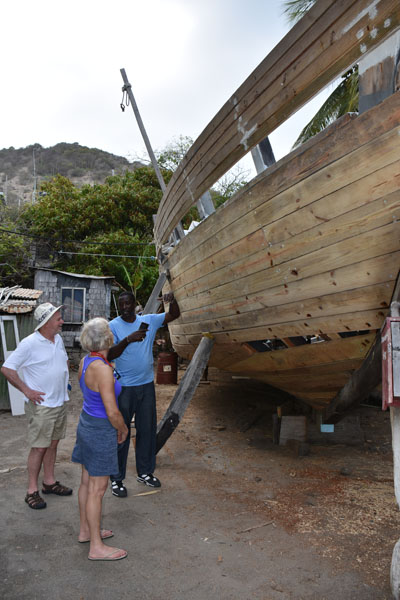 The kayaks on Carriacou still build the wooden boats by hand the way their ancestors did
The kayaks on Carriacou still build the wooden boats by hand the way their ancestors did
Horizon Yacht Charters recommends several sailing itineraries, all designed to give you the maximum enjoyment of your time exploring what this island nation has to offer. After a yacht and itinerary briefing, having bought our supplies at the local supermarket the night before, we set off after lunch with our first stop around the most southwestern part of the island, Point Salines, and up the coast to Moliniere Bay where we picked up a mooring ball for the night. It was like reliving history floating right in the spot where the French anchored to recapture the island from the British in 1779.
The Molinere Beausejour Marine Protected Area is home to the world’s very first Underwater Sculpture Park. The area encompasses six square kilometres of marine area subject to sedimentation from erosion. There are over 100 individual statues which form 13 pieces of art depicting Granada’s history, culture, and folklore. The statues have become a haven for marine life, easing the environmental pressure on other reefs in the area. They are simply awe inspiring to view and an easy snorkel from where our boat was moored.
Sailing up the west coast of the island of Grenada was breathtaking with its magnificent green mountains shrouded in mist. Making sure to skirt the required five kilometre radius around the active submarine volcano, Kick-‘em-Jenny, we arrived in Tyrell Bay, Carriacou, and easily put down an anchor in late afternoon. We felt like explorers discovering a new destination until we counted six boats at anchor proudly flying their Canadian flags. Piling into the dinghy we motored over to the Lazy Turtle Pizzeria to enjoy fresh fish and local pizza, washed down with local beers. There was also a huge selection of local fresh conch (which the locals refer to as Lambi) curried or fried.
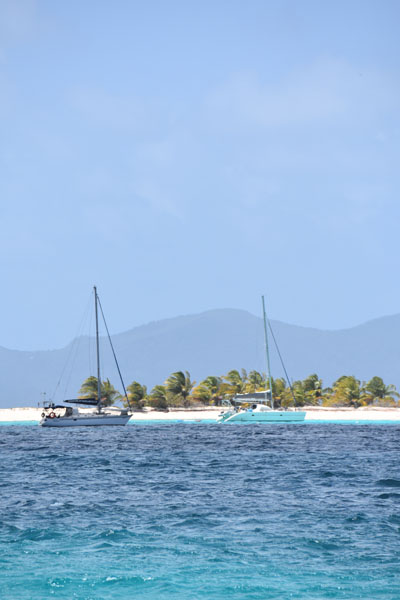 Mooring balls are easy to pick up at Sandy Island
Mooring balls are easy to pick up at Sandy Island
The next morning, we sailed out of the harbour and around the western tip of the island, past the Sister Rocks to pick up a mandatory mooring ball at Sandy Island. After being hurricane-free for 49 years, Ivan arrived, destroying 90% of the homes. Sandy island was completely stripped bare of all vegetation. After the hurricane, a natural reef was formed by broken shells and coral on the northern shore. The locals soon arrived with plantings of palm trees and local ground cover to stop the erosion and bring the island back to its original state.
After a refreshing swim we motored over to L’Esterre Bay to pick up another mooring ball and meet up with our tour guide, Lincoln, arranged for us by the Grenada Tourism Authority.
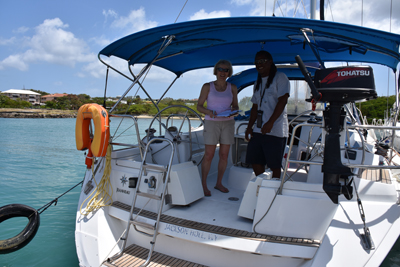
Katherine Stone going over the briefing with Horizon Yachts professional crew
Carriacou means land of reefs and one could easily see why as we wound our way up the narrow roads with large steep ditches, driving on the left for a fantastic aerial view! Natural groves of mangroves, where oysters grow naturally, were easily visible. The locals are known as Kayaks, which is certainly much easier to say than Carriacouians, making their living as farmers, fishermen, or in the tourism industry. The Kayaks have passed down through generations of their Scottish forefathers, a seafaring lifestyle and boatbuilding traditions. Today, large sloops and schooners are still being built using white cedar and the traditional methods in the village of Windward. Lincoln made sure to drive us around to the village where we could see first hand a wooden cargo boat being built. When finished boats are ready for launch, there is a big christening party where everyone comes, bringing local eats and drinks to enjoy with neighbours. Goats, sheep, and cattle freely roam the countryside and streets during the dry season, often eating the dropped leaves of the Acacia plant. Heavily decorated with bear thorns, these plants were used to keep slaves on the plantations during in the early 1800s. The colonial history of Grenada is characterized by permanently changing ownership between the French and English and the agricultural exploitation by plantations and slavery.
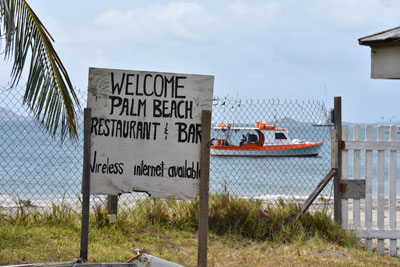 Lunch was fun at the Palm Beach restaurant
Lunch was fun at the Palm Beach restaurant
Before heading back to the boat, we had a delightful meal at the Off the Hook beach restaurant sampling local spiny lobster done in curry spices. Many suggested that we try lionfish – white, flaky fish with a flavour between grouper and mahi mahi and a touch of butteriness. Only the spines contain the venom and there is no poison in the flesh of the lionfish meat. Lionfish have no natural predators and enjoy dining on the local coral, so eating them help the reefs and native fish stocks recover, not to mention again how delectable they are!
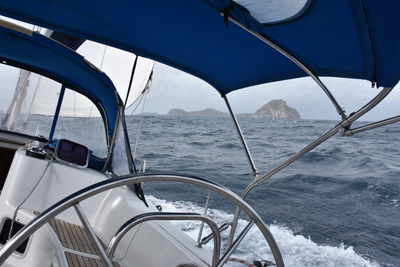 It was a quick sail back from Carriacou to mainland Grenada
It was a quick sail back from Carriacou to mainland Grenada
On the Friday we decided to take in lunch and a stroll on Petite Martinique. Carefully navigating the reefs, we passed the palm umbrella and when it was on our stern we went left toward the local docks and picked up a mooring ball designated for the Palm Beach Restaurant. It was a fun afternoon enjoying the local foods at this quaint beach eatery and walking around the local streets. Back on board, we headed toward Sandy beach for one last amazing snorkel on the northwestern part of the island by the channel marker. We celebrated our 40th wedding anniversary and reminisced about our first charter on our honeymoon many years ago and, like then, we were the only vessel in the whole anchorage that night. With the wind at our backs, we made a quick get-away the next morning and followed our course back home to True Blue Bay in half the time.
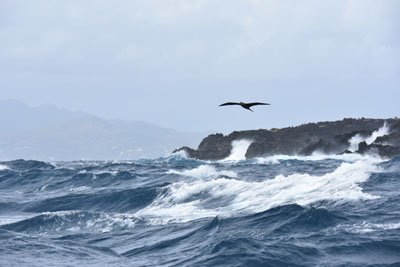 wind and waves are plentiful on the sail between the islands
wind and waves are plentiful on the sail between the islands
Not interested in just cruising and want to take in some local regattas? In late January there are two regattas with totally different clientele. The Westerhall White Jack Work Boat Regatta staged on Grand Anse Beach provides spectacular, competitive racing in wooden, bamboo-rigged boats, between the island’s traditional fishing communities. The Island Water World Grenada Sailing Week is a regatta for racing sailors at the Grenada Yacht Club. During the first week in June is the Petite Martinique Whitsuntide Regatta for many boats from various classes with fun on-shore activities. Finally, during the first weekend in August is the Carriacou Regatta in Hillsborough Bay, run since 1965, and focusing mainly on the locally-built workboat with 12 different classes of boats ranging from 14 to 35 feet.
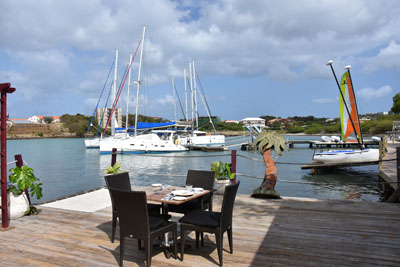 True Blue Bay Resort features beautiful rooms, the Dodgy Dock restaurant, pool and water sports
True Blue Bay Resort features beautiful rooms, the Dodgy Dock restaurant, pool and water sports
If you are looking for a charter motoring from anchorage to anchorage this is not the place. In Grenada, our sails were always full and by day’s end with the anchor hooked, the clink of your glass with crewmates came with a warm smile and sense accomplishment.
www.puregrenada.com
www.grenadagrenadines.com
https://horizonyachtcharters.com/grenada/




























